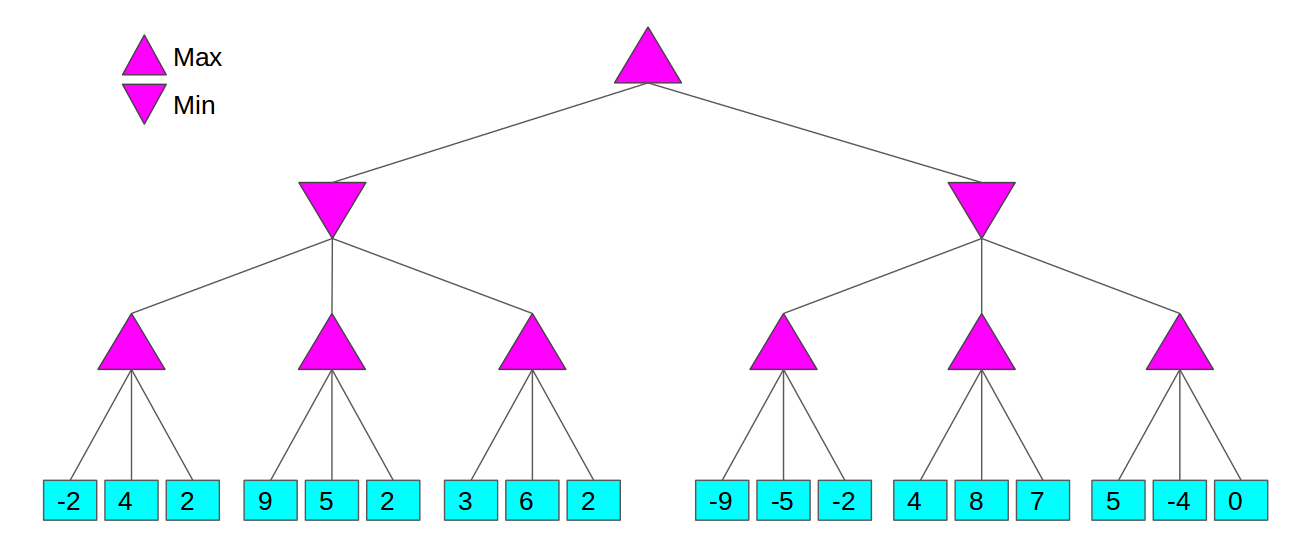Homework 3
Total points: 100 (5% of the final grade)
Due Date: 1.10pm EST, 13th October 2016
Late submission: 1.10pm EST, 18th October 2016
Submission method: Paper (in class)/ Electronic (submit system - PDF FILES ONLY!)
Submission hw name:hw3
-
Answer each of the following questions in no more than a single sentence!
(3 points each * 5 = 15)
- Given a function f(x) that defines the space, what is the update function for gradient descent? (the next value to go to)
- Give one way to deal with local optima for gradient descent.
- How many optima does the function
f(x,y)= x^2 + y^2have? - What is the significance of "temperature"(T) in simulated annealing?
- What is the purpose of mutations in Genetic algorithms?
-
Consider the minimax tree shown below

-
(5 points) Use the minimax algorithm to fill in values for each of the nodes. Indicate the optimal path taken from the root node to the leaf node (using arrows)
-
(20 points) Use the alpha-beta pruning with minimax algorithm on the same tree.
- For each max node, write down the changes of the value of alpha
- For each min node, write down the changes of the value of beta
- Show pruned nodes with a single horizontal line across the node
- How many nodes were successfully pruned? (including non-leaf nodes)
-
-
Consider the following CSP
- 4 Variables: X1, X2, X3, X4
- Domains:
- D1 = {1, 2, 3, 5}
- D2 = {2, 3, 4, 8}
- D3 = {4, 5, 7, 8}
- D4 = {0, 1, 2, 4, 7, 9}
- Constraints:
- X1 >= X2
- X2 > X3 or (X3 - X2) = 3
- X4 < X3
Answer the following questions
- (5 points) Draw the constraint graph
- (5 points) Is the network arc consistent? Justify
- (20 points) Run the AC3 algorithm to make the network arc consistent. Things to show at each step of the algorithm:
- Queue status
Hint: Each ordered pair of constrained variables is added into the queue.
Eg: [(X1,X2), (X2,X1), (X1, X3), (X3, X1)] - The domain values
Hint: After each pair of variables from the queue is processed, their corresponding domains are reduced to ensure arc consistency
- Queue status
-
Consider the following scenario: Your partner finds several inappropriate text messages on your phone and gets suspicious that you are cheating. You try to convince him/her that it is some random person but he/she asks you to prove it by taking a lie detector test!
You get an at-home lie detector that has the following information on the box. It boasts a true positive accuracy of 97% i.e. the probability of you failing the lie detector test if you did indeed cheat is 0.97 . In tiny font, it also lists its false positive rate of 2.5% i.e. the probability of you failing the test even if you didn't actually cheat is 0.025 .
He/she quotes a tabloid magazine that says "3 out of 10 people cheat on their partners" and vows to break up if the probability that you cheated after taking the test is more than 0.1 . The test is administered and behold, you fail!
(10 points)
- What is the probability that you cheated before you even took the test? (prior)
- What is the probability that you cheated after you failed the test? (posterior)
Failing the lie detector test makes you start to panic! You start to search online and find a credible research study that concludes "Only 1 in 1000 CS students actually cheat on their partners because they tend to have no life outside of coding". You get excited because you are a CS student!
(10 points)
- Can you convince your partner to stay with you using probabilistic arguments? (what is the probability that you have cheated given this new information?)
Your partner is still not convinced! He/she asks you to take the test again and behold, you fail again!
(10 points)
- Assuming the two tests were independent of each other, could you still convince your partner to not break up with you? (what is the probability that you have cheated given you failed twice and you're a CS student?)

